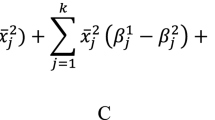Summary
The annual incidence of alcoholism among males in the Lundby Community Cohort (n=2,550), prospectively observed during the period 1957–1972, was found to be highest for workers (340 per 100,000), which was much higher than for self-employed businessmen, artisans, and farmers (230 per 100,000) or for ‘white collar’ employees (190 per 100,000). The findings support earlier suggestions that class creates alcoholics at different rates through their general class situations.
Similar content being viewed by others
References
Biddle BJ, Bank BJ, Marlin MM (1980) Social determinants of adolescent drinking. What they think, what they do and what I think and do. J Stud Alcohol 41: 215–241
Burns TF (1980) Getting rowdy with the boys. J Drug Issues Spring 273–286
Carlsson G (1977) Crime and behavioral epidemiology. Concepts and applications to Swedish data, In: Mednick S, Christiansen KO (eds) Biosocial bases of criminal behavior. Gardner Press, New York, pp 25–43
Dooley D, Catalano R (1980) Economic change as a cause of behavioral disorder. Psychol Bull 87: 450–468
Hagnell O (1981) The Lundby Study on psychiatric morbidity (Sweden). In: Mednick SA et al (eds) Prospective longitudinal research. An empirical basis for the primary prevention of psychosocial disorders. Oxford University Press, Oxford, pp 189–206
Harré R (1980) The notion of causality. Br J Psychiatry 137: 578–579
Kassen Fischer A, Marton J, Millman EJ, Srole L (1979) Longrange influences on adult mental health: the Midtown Manhattan Longitudinal Study, 1954–1974. In: Simmons RG (ed) Research in community and mental health. JAI Press, Greenvich, CT, pp 305–333
Leighton DC, Hagnell O, Leighton AH, Harding JS, Kellert SR, Danley RA (1971) Psychiatric disorders in a Swedish and a Canadian community. An exploratory study. Soc Sci Med 5: 189–209
Mello NK (1981) Etiological theories of alcoholism. Synopsis of Mary Cullen Research Trust Etiology Monography Prize Paper, 1980. Adv Alcohol 2
Murphree HB (1976) Some possible origins of alcoholism. In: Filstead WJ et al (eds) Alcohol and alcohol problems: new thinking and new directions. Ballinger, Cambridge, MA, pp 135–165
Nilsson I, Rydberg U (1979) The impact of alcohol on health. In: The use of tobacco and alcohol and its influence on health. Committee for future oriented research. Report from the research survey “Changing health conditions and individual health”, Stockholm, December 1979. Health Soc 4: 46–97
Öjesjö L (1980a) The relationship to alcoholism of occupation, class and employment. J Occup Med 22: 657–666
Öjesjö L (1980b) Prevalence of known and hidden alcoholism in the revisited Lundby population. Soc Psychiatry 15: 81–90
Öjesjö L, Hagnell O, Lanke J (1983) Incidence of alcoholism among men in the Lundby community cohort, Sweden, 1957–1972. Probabilistic baseline calculations (To appear in) J Stud Alcohol
Parker DA, Brody JA (1980) Risk factors for occupational alcoholism and alcohol problems. In: Alcoholism in the workplace. Research Monograph series. National Institute on Alcohol Abuse and Alcoholism, Rockville, MD
Pearlin LI, Radabaugh CW (1976) Economic strains and the coping functions of alcohol. Am J Sociol 82: 652–663
Sclar ED (1980) Community economic structure and individual well-being. A look behind the statistics. Inter J Health Seru 10: 563–579
Smart R (1979) Drinking problems among employed, unemployed and shift workers. J Occup Med 21: 731–736
Sulkunen P (1981) The wet generation. Living conditions and drinking patterns in Finland. Continuities in a reanalysis of Finnish drinking survey data. Paper presented at the 27th International Institute on the Prevention and Treatment of Alcoholism (epidemiology Section), Vienna, Austria, 15–20 June
Thompson WD, Weissman MM (1981) Quantifying lifetime risk of psychiatric disorder. J Psychiatr Res 16: 113–126
Wheaton B (1978) The sociogenesis of psychological disorder: reexamining the causal issues with longitudinal data. Am Sociol Rev 43: 383–403
Author information
Authors and Affiliations
Additional information
Supported by grant No. 80/405 from the Delegation of Social Research in Sweden, and by grant No. 71/2 from the Bank of Sweden Tercentenary Foundation.
Rights and permissions
About this article
Cite this article
Öjesjö, L., Hagnell, O. & Lanke, J. Class variations in the incidence of alcoholism in the Lundby Study, Sweden. Soc Psychiatry 18, 123–128 (1983). https://doi.org/10.1007/BF00583562
Accepted:
Issue Date:
DOI: https://doi.org/10.1007/BF00583562




